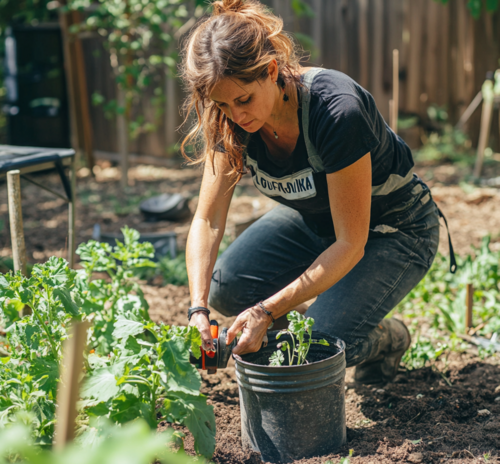The Top 5 Ways to Be a Frugal Gardener
Introduction
Gardening offers countless benefits, from growing your own food and herbs to designing a personal oasis right in your backyard. However, the costs can quickly add up, making it a potentially expensive hobby.
How can you cultivate a beautiful, productive garden without breaking the bank? Here are our top five tips for becoming a frugal gardener, helping you save money while still achieving the garden of your dreams.
1. Start From Seeds

A Gardener Plants Seeds in a Raised Bed
Starting your garden with fully grown plants might seem like the easiest route, especially for beginners, but it’s also the most expensive. Growing plants from seeds is not only cost-effective but also allows you to explore a wider variety of plants.
While starting from seeds may seem intimidating, it’s simpler than you might think. Many plants are easy to sow directly into your garden, and some even self-seed, meaning they’ll return year after year with minimal effort. Self-seeding plants like marigolds, poppies, and dill can reduce your gardening costs over time.
By choosing seeds over mature plants, you’re not only saving money but also gaining a rewarding gardening experience as you nurture your plants from the very beginning.
Additional Tip:
For best results, research the specific needs of the seeds you’re planting. Some seeds require stratification (a period of cold) or scarification (nicking the seed coat) before planting to encourage germination.
2. Share Tools & Advice
Gardening can be a solitary activity, but connecting with other gardeners—either online or in person—can be invaluable. Not only can you exchange tips and advice, but you can also share tools, seeds, and plants, which can significantly cut down on costs.
Look for local gardening clubs, community gardens, or online forums where you can connect with like-minded individuals. Sharing tools like shovels, pruners, and even lawn mowers reduces the need for each gardener to purchase and maintain their own set of tools. This is especially beneficial for large or rarely used equipment.
Additional Tip:
Organize a plant swap event with neighbors or friends, or host a small-scale farmers’ market to share excess produce. This not only saves money but also builds a sense of community.
3. Recycle & Repurpose

A Gardener Repurposes a Bucket as a Garden Planter
Instead of buying new planters, barriers, or garden decor, look around your home for items that can be recycled or repurposed. Almost anything can become a garden tool with a bit of creativity.
Old teacups, mugs, and bowls can be transformed into unique planters by drilling drainage holes in the bottom. Cardboard boxes can be laid down as a biodegradable weed barrier, while plastic containers like yogurt cups make excellent seed-starting pots. Additionally, eggshells, coffee grounds, and even banana peels can be used to create nutrient-rich fertilizers for your garden.
Additional Tip:
Scour local thrift stores or garage sales for inexpensive items that can be repurposed in your garden. This not only saves money but also adds a personal touch to your garden space.
4. Be Smart with Your Water Use
Water is a precious resource, and controlling your garden’s water usage is a smart way to save money and help the environment.
One effective method is to collect rainwater for use in your garden. Setting up a rain barrel is simple—just attach a downspout to the barrel and let nature do the rest. Rainwater is free and naturally soft, making it ideal for your plants.
Another water-saving strategy is to install a drip irrigation system. Unlike traditional hoses or sprinklers, drip irrigation delivers water directly to the plant roots, reducing waste through evaporation and runoff. This targeted watering method ensures that your plants receive the moisture they need while minimizing water usage.
Additional Tip:
Mulching your garden beds can help retain soil moisture, reducing the need for frequent watering. Organic mulches like straw, wood chips, or leaves also break down over time, enriching the soil.
5. DIY Compost

Eco-Friendly Composting: Wooden Bin for Sustainable Garden Waste Management
Store-bought compost can be expensive, but making your own is easy, cost-effective, and environmentally friendly. Composting allows you to recycle kitchen scraps and yard waste, turning them into nutrient-rich soil amendments that will nourish your plants.
To start composting, set aside a designated bin or area in your yard for organic waste. Add a mix of green materials (like fruit and vegetable scraps) and brown materials (like leaves and cardboard) to create a balanced compost pile. Turn the compost regularly to speed up decomposition, and in a few months, you’ll have rich, dark compost ready to use in your garden.
Additional Tip:
If you have limited space, consider a worm bin for composting. Worms can break down food scraps quickly, producing high-quality compost known as worm castings.
Final Thoughts on Saving Money in Your Garden
Gardening on a budget doesn’t mean sacrificing quality or beauty. By starting from seeds, sharing resources, recycling materials, conserving water, and making your own compost, you can create a thriving garden without overspending.
Which of these frugal gardening tips are you most excited to try? Implementing even a few of these strategies will help you save money while enjoying all the benefits of a flourishing garden.
Originally posted on March 21, 2019.


